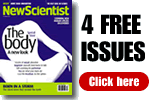How to create a crystal made entirely of holes

- 15:31 08 December 2005
- NewScientist.com news service
- Will Knight
Related Articles
- 'Hot' superconductor surprise baffles physicists
- 26 November 2005
- Micro-organisms may be turned into nano-circuitry
- 06 October 2005
- Nanowire splicing to make ultra-small circuits
- 30 June 2005
- Search New Scientist
- Contact us
Web Links
Computer experiments have revealed that crystal-like structures can be formed entirely from the "holes" left behind as electrons move through a semiconducting material.
Crystals are normally made from naturally repeating, three-dimensional patterns of atoms. Synthesising crystals from electron holes could lead to novel superconducting materials that function above the extremely cold temperatures currently required, according to the researchers involved.
Physicists first predicted in the 1960s that exciting the electrons in semiconductors might cause the holes left behind to form a crystalline structure. But the conditions required to make this happen remained unclear.
Now a team led by Michael Bonitz at the Institute of Theoretical Physics and Astrophysics at Kiel University, Germany, has used computer simulation to study the behaviour of electron holes within a semiconductor and determine how they can be coaxed into forming the unusual crystalline structures.
Three rules
The researchers discovered that a crystal of holes should form when three criteria are met. First, the material must be cooled to about 10°Kelvin. Second, after excitation, it must have a sufficiently high density of holes – about 1020 per cubic centimetre.
Finally, each hole must have an "effective mass" about 80 times that of an electron in the material, meaning it must have the same effect on the electron as a much heavier particle.
Under these conditions, the computer simulations suggest that a repeating structure of holes will spontaneously emerge. Each hole repels other holes, causing them to “crystallise” at a set distance from one another.
A video clip (4.8MB avi file) of the computer simulation shows holes (pink and red) forming crystal-like patterns surrounded by a gas-like cloud of electrons (yellow and blue). The variation in colour corresponds to each of the quantum spin states of each electron or hole, but this is not important to the formation of the crystal structure.
Real-world uses
Bonitz says it should be possible to meet these criteria in the laboratory, using a laser to excite a semiconducting material or perhaps by compressing it. He told New Scientist that such materials could find important real-world applications: "It could mean superconductivity at higher temperatures."
Superconductivity normally occurs close to absolute zero (-273°C), so it can be costly and complex to achieve. Some existing technologies already exploit superconductors, for example magnetic resonance imaging (MRI) scanners and power generators.
But superconductors that work at less extreme temperatures might also find uses in computers, antennas and power lines.
Journal reference: Physical Review Letters (DOI:10.1103/PhysRevLett.95.235006)










